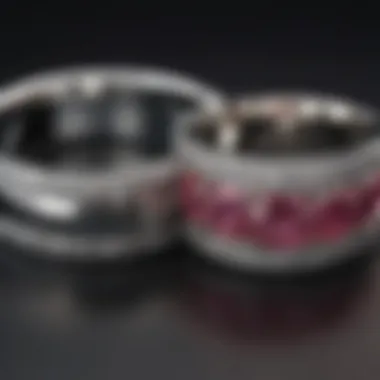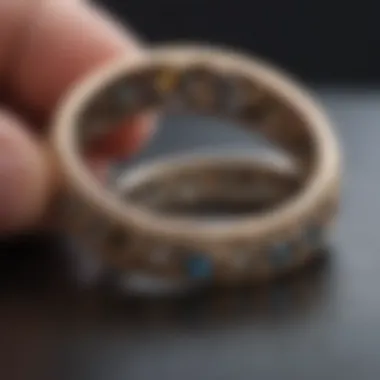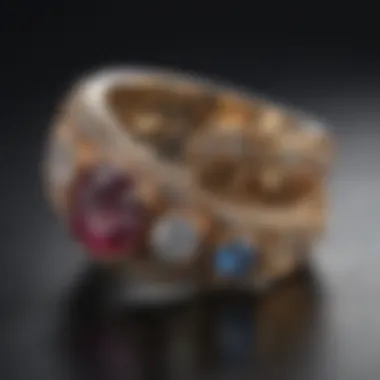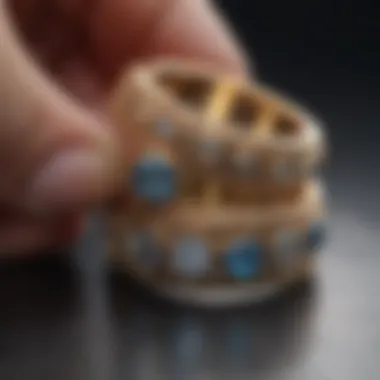Solutions for Oversized Wedding Bands: A Comprehensive Guide


Intro
The issue of oversized wedding bands often arises as a significant concern for wearers. Many individuals might receive a wedding band that does not fit as intended due to various factors during the purchasing process. This challenge can affect comfort, style, and even the longevity of the ring itself. Addressing this matter is crucial, as it impacts how the ring is perceived and used daily.
In this article, we will delve into the implications of wearing a wedding band that is too large, the solutions available for resizing, alternatives to consider, and the importance of proper ring maintenance. Understanding these factors helps inform both consumers and jewelers about the complexities of wedding band sizing, ensuring better decisions when selecting and maintaining these important pieces of jewelry.
Understanding the Problem
An oversized wedding band presents practical challenges. It can easily slip off during daily activities, leading to potential loss and emotional distress. Additionally, constantly adjusting or worrying about a ring's fit can detract from the joy of wearing it. Beyond these practical inconveniences, an ill-fitting band can also reflect on the wearer’s style choices, suggesting carelessness or a lack of attention to detail.
To provide clarity on this issue, we will explore various topics related to oversized wedding bands, offering insight into effective solutions while ensuring that both consumers and jewelers are equipped with the necessary knowledge to navigate this common dilemma.
Solutions for Oversized Wedding Bands
When faced with the challenge of an oversized wedding band, individuals can explore multiple options to improve the fit.
Resizing Options
One of the most common solutions is resizing the ring by a qualified jeweler. Resizing involves adjusting the band to fit snugly around the finger. Jewelers can either increase or decrease the size through specific techniques:
- Reducing Size: This process is executed by cutting the band, removing a section, and then soldering the ends back together.
- Increasing Size: This can be more complicated, involving inserting additional metal to expand the band.
Before proceeding with resizing, it is advised to consult with a professional jeweler to evaluate the ring's materials and design, as some bands cannot be resized effectively.
Alternative Methods
In cases where resizing is not feasible, alternative methods may be helpful. These include:
- Ring Guards: These are inserts placed within the band to snap in place, creating a tighter fit without permanent changes.
- Sizing Beads: Small metal beads added to the interior of the ring can help create a snugger fit.
Each of these options provides a unique solution to enhance comfort and security for the wearer.
Importance of Maintenance
Maintaining the condition of a wedding band can also play a role in preventing fitting issues. Regular check-ups with a jeweler for cleaning and inspection can identify wear that leads to a loose fit. Understanding that maintaining the integrity of the ring helps avoid complications is essential for future enjoyment.
"An oversized wedding band can cause not just discomfort, but also anxiety about losing a treasured piece of jewelry. Regular maintenance and resizing when necessary are key to preserving its significance."
This comprehensive approach, from resizing to maintenance, highlights likely solutions to the issue of oversized wedding bands, ensuring that wearers fully appreciate their rings without inconvenience.
Prologue to Wedding Band Sizing
Understanding the principles of wedding band sizing is essential for both consumers and professionals in the jewelry field. A perfect fit is not only about aesthetics but also about comfort and safety. When a wedding band does not fit properly, it leads to practical concerns that go beyond mere looks. This section offers key insights into the various aspects of wedding band sizing, so we can ensure optimal fit and satisfaction.
Understanding Ring Size Measurements
Ring sizes can be measured in several ways. The most common system is the numerical size, which typically ranges from sizes 3 to 13. Each size corresponds to a specific circumference measured in millimeters. Jewelers often use a tool called a ring sizer, which features incremental adjustments allowing for precise measurements. In some regions, sizes are designated using letters, though this system is less common.


Another method of determining size is to measure the inner diameter of a ring that already fits correctly. The correct dimensions allow for future reference, especially if a resizing is necessary.
It is important to remember that different styles of rings may fit differently. A wide band may feel tighter than a narrow band even if they share the same size.
Common Causes of a Loose Wedding Band
Loose wedding bands are quite prevalent and can be attributed to several factors. One reason is the natural fluctuation in body temperature, which can alter the size of fingers throughout the day. Weight changes, whether gain or loss, can also affect ring size drastically. Environmental factors such as weather can lead to temporary changes in fit. Additionally, certain ring styles are inherently looser due to their design.
Inadequate initial measurements can lead to long-term issues. Sometimes, the ring may stretch, particularly if made from softer metals. All these elements culminate to present a significant concern for wearers, warranting a deeper engagement with the topic of sizing.
Understanding these basics helps individuals make informed decisions when purchasing wedding bands. Recognizing the nuances in sizing ensures that the rings are not just a visual declaration of love, but also symbols of comfort and safety.
Implications of an Oversized Ring
Understanding the implications of an oversized wedding band is crucial not only for the wearer but also for jewelers and designers. An ill-fitting ring can lead to several issues that go beyond mere aesthetic concerns. Therefore, it is vital to recognize these elements since they can have significant consequences in terms of safety and emotional well-being.
Safety Concerns with Loose Rings
A loose wedding band may seem like a minor inconvenience, but it can pose serious safety hazards. The primary concern is the risk of losing the ring altogether. Situations where one can lose their ring include daily activities such as washing hands, performing sports, or engaging in manual labor. An oversized band can slip off quite easily, leading to potential heartache over a lost symbol of commitment.
In addition, safety should not be underestimated in professional settings, especially for those who work with machinery or in situations where rings can get caught. An oversized ring can easily snag and cause injury. This reality highlights the necessity for individuals to ensure that their wedding band fits snugly to minimize risk during both routine and challenging tasks.
"A proper fit is not just about comfort; it is also about safety and security in daily life."
Emotional Impact of an Ill-Fitting Band
The emotional implications of wearing an oversized wedding band are often overlooked. A ring that does not fit properly can trigger feelings of insecurity and dissatisfaction. For many, a wedding band serves as a tangible representation of love and commitment. When it feels uncomfortable or is frequently at risk of being lost, it can undermine the very sentiments it is supposed to reflect.
Furthermore, wearing a ring that slips or feels awkward can detract from a person's confidence. Rather than being a reminder of love, it transforms into a source of distraction and frustration. These emotional responses are essential to consider, as they can affect how individuals perceive their relationship and self-image.
In summary, the implications surrounding oversized wedding bands encompass critical safety and emotional dimensions. Ensuring that a wedding band fits properly is not merely a question of aesthetic value; it is a matter of safety and personal comfort that can directly influence one's quality of life.
Resizing Options for Oversized Wedding Bands
Addressing the challenge of oversized wedding bands is essential for ensuring both comfort and aesthetics. A wedding band that fits correctly not only adds to the wearer's personal style but also minimizes potential hazards associated with a loose fit. Understanding resizing options is crucial, as the choices directly affect the longevity and functionality of the ring.
Professional Resizing Services
When faced with an oversized wedding band, professional resizing is often the most reliable option. Jewelers possess the skills and tools necessary to resize rings safely and effectively.
Here are some advantages of opting for professional resizing:
- Expertise: Jewelers have trained eyes and hands, capable of assessing the type of metal, design intricacies, and stone settings.
- Tools: Specialized tools are required for precise resizing without compromising the ring's integrity.
- Post-Resize Warranty: Many jewelers offer a warranty on their adjustments, providing peace of mind about the work done.
However, there are considerations to keep in mind:
- Cost: Professional resizing services can be expensive, varying widely based on the complexity of the job.
- Time: Some resizing jobs may take time, especially if the jeweler has a busy schedule.


This highlights the importance of selecting a reputable jeweler and communicating your needs clearly.
DIY Resizing Techniques
For those who prefer a hands-on approach, several DIY techniques can be employed to manage a loose wedding band. While these methods can be useful, they require caution to ensure the integrity of the ring is maintained.
Here are some popular DIY methods:
- Ring Adjusters: Rubber or silicone adjusters can be easily applied to the inner band. This option is effective and can be removed without damage when no longer needed.
- Sizing Bumps: Small, round pieces can be affixed to the inner surface of the band. This provides a quick adjustment and a snugger fit without altering the ring's structure.
Important: While DIY methods can serve as temporary solutions, they may not be as durable as professional resizing. Regular assessment of the ring's fit is advisable.
Alternative Solutions for Managing Loose Rings
Managing a wedding band that is too large for the finger can be a significant concern for many individuals. While resizing the ring is often the most straightforward solution, it may not always be necessary. Especially when considering alternative solutions to manage loose rings, several methods offer practical and effective ways to secure a comfortable fit. These solutions can be easily implemented, enhance comfort, and minimize the risk of losing the band.
Ring Adjusters and Inserts
Ring adjusters are small devices designed to improve the fit of oversized rings. They are generally made from soft materials that can function to fill space between the ring and the finger. This ensures that the ring fits more snugly without requiring any permanent modifications.
- Benefits include:
- Comfortable Fit: They provide immediate relief by minimizing movement on the finger.
- Convenience: Adjusters can be applied without professional assistance, offering a quick fix.
- Versatility: Most adjusters can be used on various types of rings, regardless of design.
There are many types of ring adjusters available. Some are adhesive strips that secure to the inner band, while others are flexible bands that wrap around the ring. When selecting an adjuster, it is essential to consider the thickness and material of your wedding band to ensure proper attachment without causing damage.
Using Sizing Bumps
Another practical approach to handling oversized wedding bands is the use of sizing bumps. Sizing bumps work by creating a physical barrier within the band that reduces its internal circumference.
- Key aspects:
- Simple Application: Sizing bumps can be added inside the ring and don’t require professional installation.
- Cost-Effective: This method tends to be less expensive than resizing or purchasing a new band.
- Temporary Use: Sizing bumps can be removed if conditions change, such as weight fluctuation or finger swelling.
Applying sizing bumps involves measuring the size carefully and then either acquiring adhesive bumps or custom-made options designed specifically for this purpose. Always ensure that they fit securely within the band to avoid shifting or discomfort.
Remember: Choosing the right solution depends on personal comfort and style flexibility. Sometimes temporary adjustments can be an effective way to manage an oversized ring without permanent alterations.
Incorporating these alternative methods for managing loose wedding bands offers individuals various options for comfort and security. They address immediate challenges without necessitating the more significant financial or time commitments of resizing, providing both versatility and practicality.
Preventing Future Sizing Issues
Preventing future sizing issues is crucial for ensuring that wedding bands fit comfortably and securely. A properly fitted ring not only enhances aesthetics but also alleviates the discomfort caused by a loose or tight band. When couples consider future ring sizing, they should be aware of various factors that can affect the fit over time. Understanding these factors can assist in making informed decisions that prolong the ring's usability and comfort.
Understanding the Factors Affecting Fit
Several elements influence how a wedding band fits, and recognizing these can help in maintaining an ideal size.


- Body Temperature: Ring size can fluctuate with changes in body temperature. In warmer weather, fingers may swell slightly, making rings feel tighter. Conversely, colder temperatures can cause fingers to shrink.
- Weight Changes: Weight fluctuations can have a direct impact on finger size. Gaining or losing weight can cause fingers to swell or shrink, affecting how the ring sits on the finger. This can lead to situations where an originally well-fitted band may no longer feel comfortable after significant weight change.
- Hydration Levels: Dehydration can lead to a decrease in finger volume, while increased hydration can cause temporary swelling. Being mindful of hydration helps in selecting a suitable ring size that accommodates such variations over time.
- Activity Level: High activity or exercise can temporarily affect finger size due to swelling from exertion. Consideration of activity levels is wise when determining ring size, especially for those with demanding lifestyles.
Understanding these factors is essential for both individuals and jewelers. By being aware of how body conditions affect fit, they can better predict potential sizing problems and take necessary steps to prevent them.
Choosing the Right Size and Style
Selecting the correct size and style when purchasing a wedding band is a fundamental step in preventing future sizing issues. An ill-fitted ring can cause discomfort and lead to a myriad of problems. Here are key considerations when choosing:
- Accurate Measurement: Always get an accurate measurement of your ring size right before purchasing. This can be done by a professional jeweler using proper tools.
- Consider Width: The width of the band affects how it feels on the finger. Wider bands typically fit tighter than slimmer ones. Thus, if opting for a wide style, one may consider going half a size up to ensure comfort.
- Comfort Fit: Look for wedding bands that are designed with a comfort fit. This style features a rounded interior, which allows for easier sliding on and off while being more forgiving on fingers during fluctuations in size.
- Metal Type: Different metals can feel different on the finger. Gold, platinum, and titanium all have unique weights and thicknesses that can influence how a ring fits. This should be taken into account when choosing a ring.
- Future Considerations: Think about how long you plan to wear the band and any lifestyle changes that could occur. This foresight will assist in choosing a style that remains appropriate over time.
Choosing the right size and style not only enhances comfort but also adds to the overall enjoyment of wearing a wedding band.
"A wedding band should be a symbol of love and commitment, not an anchor of discomfort or worry over fitting."
By focusing on these aspects at the outset, individuals can minimize the likelihood of sizing issues arising after the initial purchase.
Caring for Your Wedding Band
Caring for your wedding band is essential for maintaining its beauty and integrity over time. A wedding band, often symbolizing love and commitment, is not just a piece of jewelry; it carries emotional significance. Proper care ensures that it remains in excellent condition for years to come.
The need for care is multifaceted. First, regular maintenance helps prevent wear and tear. Metals can scratch or tarnish. If not cleaned properly, dirt and oils can accumulate, impacting shine and clarity. Furthermore, understanding the value of your specific metal or gemstone is vital for effective care. Certain materials require specific handling or cleaning methods. For example, gold and platinum often need different cleaning approaches compared to more delicate materials like silver or softer gemstones.
Taking proactive steps in the upkeep of your wedding band contributes to both the appearance and durability of the ring. When rings are well cared for, they can effectively resist the rigors of daily wear. This attention to care also reflects a respect for the emotional symbolism behind the jewelry, reinforcing its significance to the wearer.
Regular Maintenance Tips
- Frequent Cleaning: Depending on your lifestyle, consider cleaning your ring at least once a month. Use mild soap and water, and gently scrub with a soft toothbrush. This removes dirt without damaging the setting or gemstones.
- Avoid Harsh Chemicals: Some cleaning agents can be too strong and may cause discoloration or damage. Household cleaners, particularly those containing bleach, can be harmful, so avoid them.
- Keep It Safe: When not wearing your ring, store it in a soft cloth or its original box. Avoid tossing it in a jewelry box where it might scratch against other jewelry.
- Check the Settings: Periodically inspecting the stones for loose fittings can prevent them from falling out. Tightening the prongs or securing loose settings is crucial to keeping your ring intact.
- Professional Cleaning: At least once a year, take your wedding band to a jeweler for a professional clean and check. Jewelers have specialized tools to ensure your ring is maintained correctly.
These tips are relatively simple, yet they can significantly extend the life and beauty of your wedding band.
When to Consult a Jeweler
It is not always easy to assess when you should seek professional help for your wedding band. Here are some indicators:
- Visible Damage: If you notice scratches, dents, or discoloration, consult a jeweler for a professional evaluation. Small issues can quickly escalate into larger, more costly repairs.
- Loose Stones: If any stones in your wedding band feel loose or are shifting position, it is advisable to seek a jeweler's expertise. The last thing you want is to lose a cherished gemstone.
- Other Concerns: If you experience discomfort or irritation while wearing the ring, it might be due to sizing issues or metal allergies. Always consult with a professional jeweler if you experience these problems.
"Understanding when to see a jeweler can save you considerable time and money in the long run. Regular consultations can ensure the longevity of your wedding band."
In a nutshell, the maintenance and care of your wedding band not only preserves its physical beauty but also protects the sentiment it carries. Regular check-ups and prompt action upon noticing any issues can make a significant difference in ensuring your band remains a lasting symbol of commitment.
End
Summarizing Key Points
In summary, the article discusses several critical areas regarding oversized wedding bands:
- Understanding Ring Size Measurements: Knowing how to measure ring size accurately can prevent the initial sizing issues that lead to oversized bands.
- Implications of an Oversized Ring: The safety risks and emotional effects indicate that a proper fit goes beyond aesthetics; it affects daily wear and personal sentiment.
- Resizing Options: Professional services as well as DIY techniques are essential knowledge for anyone dealing with oversized rings.
- Managing Loose Rings: Solutions like ring adjusters and sizing bumps offer immediate fixes for wearers who seek a quick remedy.
- Prevention of Future Sizing Issues: Insight into factors that influence fit and choosing the right size and style is critical for future purchases.
- Caring for Wedding Bands: Regular maintenance and knowing when to consult a jeweler are vital for the longevity of the ring.
The Importance of Proper Fit
The significance of a proper fit cannot be overstated. A wedding band symbolizes commitment and love, and it is meant to be worn comfortably throughout a lifetime. Inadequate fitting may lead to loss or damage of the ring, which is a frustrating experience. Moreover, a loose ring can distract you during daily activities, limiting your overall enjoyment. It is also worth noting that rings that do not fit well may create unnecessary stress or self-consciousness for the wearer.
By understanding these factors, individuals can take proactive steps to ensure that their wedding bands are both comfortable and secure. A good fit elevates the experience of wearing the ring, allowing it to serve its purpose as a cherished token of love without the accompanying worries.







